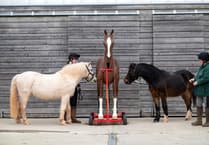TWO Dartmoor primary schools, Princetown and Widecombe-in-the-Moor, recently visited Higher Uppacott, the Dartmoor longhouse in order to help bring to life aspects of their studies.
Dartmoor has about 130 standing longhouses, buildings which remain in use to this day, some as farm buildings, but most still as private houses.
The general rarity of this resource means that the Dartmoor longhouse is regarded as having international importance.
In 1979, the Dartmoor National Park Authority bought Higher Uppacott not only with a shippon unaltered since medieval times, but also with medieval smoke-blackened thatch.
Children from Princetown Primary School spent a morning at Uppacott with their teachers and national park authority staff. The children asked questions on what life was like for Dartmoor's medieval people.
Willem Montagne, education officer for Dartmoor National Park Authority, said: 'It is always difficult for seven year olds to cast their imaginations back hundreds of years but showing them the cow or "shippon" end of the building, a dark cobbled space opened up to the timber and thatch roof, does the trick.
'One can almost smell the steaming cattle tethered there for winter, using the same doors and under the same roof as the farmer's family.
'There were lots of good questions about their food and the jobs they had to do and of course how they dealt with all that manure.'
The children from Widecombe were investigating the theme of the Tudors. Seeing the longhouse inside and out, led to questions about the developments and changes that occurred to society and the building during that time.
'This old building can bring alive the past to such a wide range of ages and be used to look at so many different subjects.'
The children also sketched details of the building and discussed how local and sustainable lifestyles must have been.
Some fascinating recordings of former residents of Higher Uppacott describing life in the heart of the moor were also enjoyed.



